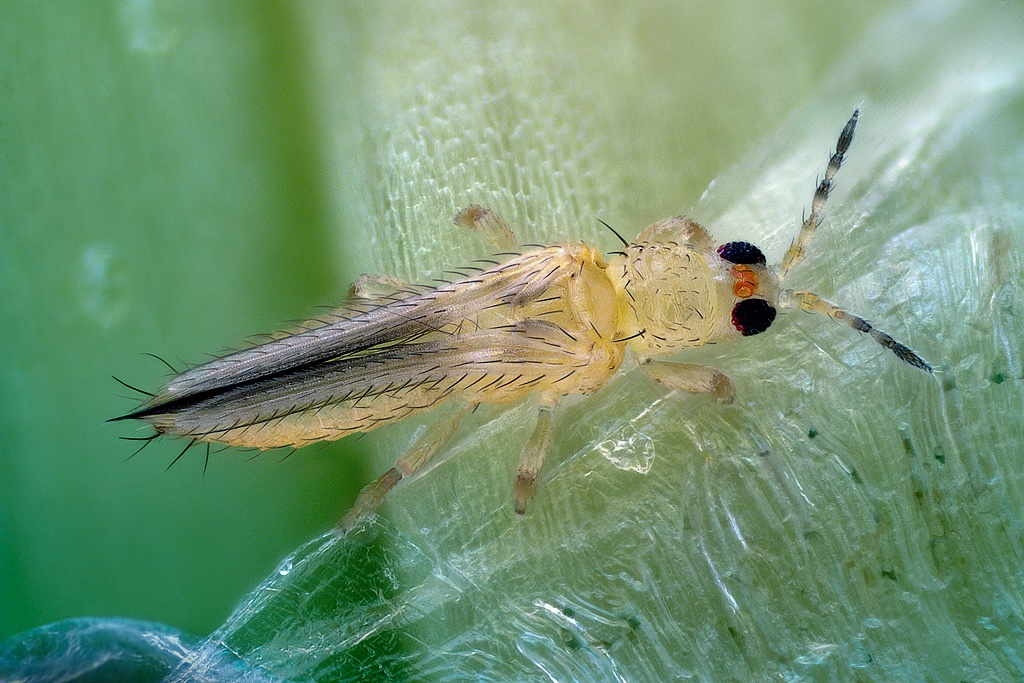Description

Copyright infringement not intended
Picture Courtesy: https://twitter.com/thrips_id/status/1205970461311537158
Context: The invasion of Thrips Parvispinus has led to 40-80% damage in chilli crops in Andhra Pradesh and Telangana, according to Union Agriculture Minister Narendra Singh Tomar's response in the Rajya Sabha.
Key Highlights
Damage Percentage
- A joint survey conducted by an expert team found that, on average, 40-80% damage to chilli crops occurred in Andhra Pradesh and Telangana.
- Thrips Parvispinus, being an invasive pest species, may have dominated or replaced the native chilli thrips, Scirtothrips dorsalis.
Possible Causes
- The change in weather and climatic conditions during the crop season may have favoured the establishment of Thrips Parvispinus, resulting in a sudden upsurge in the chilli ecosystem.
- The absence of natural enemies for the invasive pest, excessive use of chemical pesticides, and staggered plantings could contribute to the outbreak.
Policy Interventions
- Pest survey and monitoring at the district level.
- Restoration of soil fertility in chilli-growing fields.
- Regular monitoring of pesticide quality, with a focus on providing microbial and botanical pesticides to farmers.
- Restriction on the use of chemical fertilizers on chilli crops.
- Promotion of cultural practices like deep summer ploughing, intercropping, clean cultivation, and balanced use of fertilizers.
- Uprooting and destruction of plant debris.
- Implementation of Integrated Pest Management (IPM) strategies for pest control.

Action Plan
- The action plan includes various measures to control the spread of Thrips Parvispinus and mitigate the damage to chilli crops.
Polyphagous Nature
- Thrips Parvispinus is a polyphagous pest, capable of growing and multiplying on alternate hosts such as drumstick, pigeon pea, chickpea, papaya, mango, and various weed species.
Quarantine Measure
- Strict plant quarantine measures are in place for imported planting materials.
- Plants and seeds requiring post-entry quarantine are regulated as per Plant Quarantine (PQ) Order 2003.
Farmers' Response
- Many farmers left their fields unattended due to the severe incidence of thrips and other pests, contributing to the spread of thrips and pathogens to healthy fields in the vicinity.
Thrips parvispinus
- Thrips parvispinus, commonly known as the greenhouse thrips, is a tiny insect belonging to the Thysanoptera order.
- They are major agricultural pests, particularly in greenhouses and other controlled environments, causing damage to various crops and ornamental plants.
Identification
- Adults are around 1-2 mm long, slender, and yellowish-brown to brown in colour.
- They have four fringed wings, although some females might be wingless.
- Seven-segmented, dark brown, and thread-like.
- Asymmetrical piercing-sucking mouthparts are used to feed on plant sap.
Biology and Life Cycle
- Eggs: White, oval-shaped, and laid inside plant tissues.
- Larvae: Elongated, whitish-yellow, and feed on plant sap. They go through two larval stages before pupating.
- Pupae: Immobile stage is hidden in soil or plant debris.
- Adults: Emerge from pupae and are sexually mature. Females can reproduce without mating (parthenogenesis).
- Lifecycle: Depending on temperature, the lifecycle can be completed in 10-20 days.
Feeding and Damage
- Thrips parvispinus feeds on plant sap, puncturing leaves, flowers, and fruits.
- Feeding causes stunted growth, distorted leaves, silvery patches, and discoloured flowers and fruits. They can also transmit plant viruses.
|
Management
|
|
Prevention
|
●Use resistant pepper varieties.
●Monitor greenhouses and fields regularly.
●Remove weeds and debris.
●Use insect screens on greenhouses.
|
|
Biological control
|
●Release predatory mites or ladybugs that feed on thrips.
●Encourage natural enemies like spiders and lacewings.
|
|
Chemical control
|
●Use insecticides as a last resort, following label instructions carefully.
●Rotate insecticides to prevent resistance development.
|
Conclusion
- The government's response involves a multi-faceted approach, combining pest control measures, cultural practices, and policy interventions to address the challenges posed by Thrips Parvispinus to chilli crops in the region.
|
PRACTICE QUESTION
Q. What is Thrips Parvispinus, recently in the news?
A) A new species of flower
B) Invasive pest affecting chilli crops
C) Exotic bird species
D) Medicinal plant
Answer: B
Explanation:
Thrips Parvispinus has been making headlines as an invasive pest affecting chilli crops in Andhra Pradesh and Telangana. This tiny insect, belonging to the Thripidae family, has been causing significant damage to chilli plants, leading to economic losses for farmers. The outbreak of Thrips Parvispinus has become a concern in agriculture, as it has dominated or replaced native chilli thrips and caused widespread damage to the chilli ecosystem.
|












